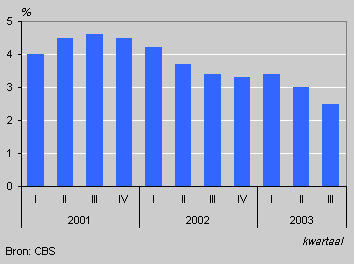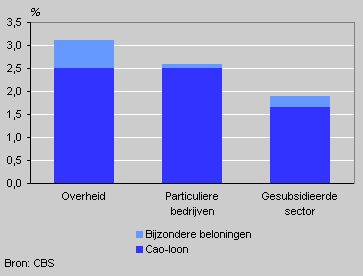Wage restraints continue

In the third quarter of 2003 wage levels in the Netherlands determined by means of collectively negotiated labour agreements were 2.5 percent higher than twelve months previously. In the second quarter these wages rose by 3.0 percent. The downward trend started in 2002. In 2001 the increase was 4.4 percent, the highest rise since 1982.
Wage increase 2.5 percent
At the end of last year, employer and employee organisations agreed to restrict the wage rises in 2003 to a maximum of 2.5 percent. As the labour agreements are made for a future period, it can take some time before central wage agreements are completely reflected in the collective wage trend. It was only in the third quarter of this year that the average rise in collectively agreed wages fell to the agreed 2.5 percent.
In the first nine months of this year the wages rose by an average 2.9 percent. Collectively agreed wages excluding special allowances also rose by 2.9 percent in this period.
Next week the Dutch cabinet will begin their traditional autumn round of wage negotiations for 2004 with representatives of employers and employees. However, half of the collective labour agreements in the private sector contain wage specifications up to and including the first quarter of 2004.
Collectively negotiated wage rises per quarter

Smaller wage rises
In the government sector the wage increase was substantially smaller. In the third quarter of 2003 the increase was 3.1 percent on twelve months previously. In the second quarter it was still as high as 4.0 percent.
In the private sector the wage increase in the third quarter was 2.6 percent. The difference with the government lies in special allowances such end-of-year and one-off bonuses. In the government sector these rose by 0.6 percent while in the private sector they remained at the same level. Excluding the special allowances, the collectively agreed wages of both the private and the public sector rose by 2.5 percent.
Collectively negotiated wage rises by sector, third quarter 2003

Small rise in subsidised sector
The smallest rise in collectively agreed wages was for employees in the subsidised sector, which mainly comprises health care and welfare. They only received 1.9 percent more in the third quarter of 2003 than in the same quarter in 2002. However, only 58 percent of the agreements in this sector were definite in September.
Han van den Berg